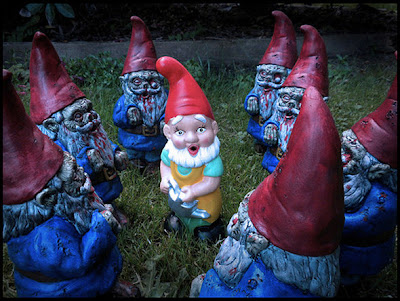| Toad lilies in the Lurie Garden |
The greens of summer have faded at the Lurie Garden in downtown Chicago, replaced by splashes of yellow, gold and various shades of brown. Yet, despite the shorter days and near-freezing temperatures at night, there's still plenty to see.
The toad lilies (Tricyrtis 'Tojen'), with their delicate spotted orchid-like flowers, are a delight. You'll also find Japanese anemones (Anemone hupehensis 'Praecox') backed by goldenrod (Solidago 'Fireworks') along the garden's easternmost edge.
And what would any respectable garden be without a few purple asters? There's the tatarian aster (Aster tartaricus 'Jindai') reaching for the skies and the much lower 'October Skies' (Symphyotrichum oblongifolium).
The toad lilies (Tricyrtis 'Tojen'), with their delicate spotted orchid-like flowers, are a delight. You'll also find Japanese anemones (Anemone hupehensis 'Praecox') backed by goldenrod (Solidago 'Fireworks') along the garden's easternmost edge.
And what would any respectable garden be without a few purple asters? There's the tatarian aster (Aster tartaricus 'Jindai') reaching for the skies and the much lower 'October Skies' (Symphyotrichum oblongifolium).
| Asters in the Lurie Garden |
Over on the other side of the boardwalk, several plants are sporadically reblooming – including the salvia that creates the garden’s famous “River” in early summer. A few coneflowers (Echinacea ssp.) can be found hiding here and there. Hyssop (Agastache rupestris) and calamint (Calamintha nepeta var. nepeta) have fewer flowers than at the height of summer but still look pretty good.
You'll also see some unusual seedheads popping up everywhere in the calamint. According to the garden's horticulturalist, Laura Ekasetya, these are bottle gentian (Gentiana andrewsii), a native Illinois prairie plant.
| Bottle gentian seedheads in the calamint |
Bottle gentian generally blooms a brilliant blue in late September, although it was a month early this year, she reported. This plant is unusual in that it takes seven years to go from seed to bloom. Now that the garden is in its eighth year, visitors will be seeing more bottle gentian in the future.
Of course, the garden's ornamental grasses are in their full glory, seed heads waving proudly in the wind off nearby Lake Michigan. The northern sea oats (Chasmanthium latifolium) especially rustle in a stiff breeze. These will eventually come to dominate the garden during the winter, but for now they are content to bide their time.
The amount of life still left in this garden surprised me last weekend. My suburban Zone 5 garden is all but finished for the season. If I needed any reminder that downtown Chicago was switched to Zone 6 in the recent revision of the USDA's plant hardiness map, I certainly got it.
I have now visited and photographed this garden, designed by famed Dutch plantsman Piet Oudolf and built over a parking garage, in all four seasons. It's been amazing each time. I'm always impressed by how a garden of this size and beauty is maintained with no chemicals using mostly volunteer labor. It shows no ill effects from this year's drought.
You hear a lot about sustainability these days. This garden is living proof it can be done. It gives me something to aspire to in my own, much more modest garden.
To see the Lurie Garden in other seasons, please click on one of the links below.
Winter Spring Summer
By Karen Geisler
| Amsonia 'Blue Ice' with Allium 'Summer Beauty' in front and common eulalia grass (Miscanthus sinensis 'Malepartus) at left back. |
| Arkansas bluestar |
| Northern sea oats |
| Japanese anemones with goldenrod in the background |


